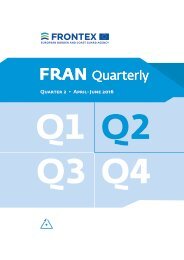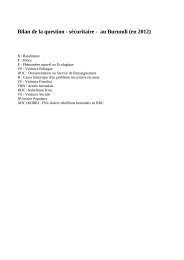Create successful ePaper yourself
Turn your PDF publications into a flip-book with our unique Google optimized e-Paper software.
AYMENN AL TAMIMI<br />
Bahrain)—one cannot seriously speak of any real territorial control, and it is<br />
doubtful the original motivation behind accepting allegiance pledges to form<br />
these provinces could be seen as achieving territorial control and implementing<br />
governance. Rather, the Algeria province primarily seems to have symbolic<br />
value as a renowned historic arena of jihad, besides presenting a chance<br />
to poach affiliates of al-Qaeda in the Islamic Maghreb (AQIM). Only very<br />
sporadic reports emerge of IS activity in Algeria, mostly relating to attacks on<br />
the Algerian army. The importance of Bilad al-Haramayn, of course, lies in<br />
its being home to the two holiest sites in Islam at Mecca and Medina. While<br />
IS has carried out a number of attacks in Saudi Arabia and expanded the<br />
scope of operations into Kuwait, claiming a suicide bombing there targeting<br />
Shiites, this points only to the existence of terrorist cells, not territorial control<br />
or governance.<br />
A more developed case, though not approaching a meaningful level of<br />
governance comparable to Iraq and Syria, is that of IS Sinai, which evolved<br />
from the pledge of allegiance of Ansar Beit al-Maqdis (Supporters of the<br />
Holy House). The Sinai affiliate has been able to conduct a number of hardhitting<br />
attacks targeting the Egyptian security forces, and it placed the bomb<br />
that downed a Russian airliner taking off from the Sharm al-Sheikh resort.<br />
The Sinai affiliate controls no major strongholds or significant contiguous<br />
territory in the peninsula, however. Documentary evidence mainly points to<br />
its distributing statements to the local population, such as warnings against<br />
cooperation with the Sisi regime or such-and-such individual on the grounds<br />
that he works with the regime, rather than administrative documents such<br />
as one sees from Iraq and Syria. Meanwhile, the Sinai media wing mostly<br />
advertises military operations and executions of spies, only occasionally featuring<br />
governance in what might be deemed proto-hisba activity, with the<br />
Hisba Department and Islamic police confiscating and destroying illicit<br />
goods like cigarettes and drugs. A more recent photo series also featured a<br />
medical clinic, but the exact location was not given, and it seems probable it<br />
is a facility set up to provide treatment for the Sinai affiliate’s own fighters.<br />
The situation in Yemen arguably provided an ideal environment for the<br />
growth of IS, with the chaotic conditions of a civil war and Sunni-Shiite<br />
sectarian tensions culminating in the takeover of the capital, Sana, by the<br />
Zaidi Shiite Ansar Allah (Houthi) movement, which is supported by Iran.<br />
In addition, one could read an October 2014 statement by al-Qaeda in the<br />
Arabian Peninsula (AQAP) as sympathetic to IS in its denunciation of the<br />
idea that the latter was a movement of khawarij (Kharijites, referring to a sect<br />
32






